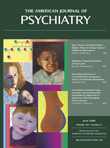More Evidence for the Role of Persistent Dissociation in PTSD
To the Editor: The report by Briere and colleagues (1) highlights the importance of persistent dissociation in the etiology of posttraumatic stress disorder (PTSD). On the basis of two cross-sectional studies, the authors conclude that “the primary risk for PTSD is less whether one dissociates during (or soon after) a traumatic event than whether such dissociation persists over time” (p. 2299). We agree with the authors’ conclusions. It is of interest to note that our article published in 2002 in the British Journal of Psychiatry(2) reported two prospective longitudinal studies of motor vehicle accident survivors and came to a remarkably similar conclusion: “Persistent dissociation and rumination 4 weeks after trauma are more useful in identifying those patients who are likely to develop chronic PTSD than initial reactions.” Participants were assessed very soon after the accident and followed for 6 months. Persistent dissociation at 4 weeks was a better predictor of chronic PTSD at 6 months than peritraumatic dissociation measured in the immediate aftermath of the trauma. Another prospective longitudinal study of assault survivors published in 2003 in the Journal of Consulting and Clinical Psychology(3) showed that persistent dissociation predicted an additional 8% variance of PTSD severity at 6 months over and above what could be predicted from trauma severity and cognitive processing measures, including peritraumatic dissociation. These findings from prospective longitudinal studies complement the cross-sectional results of Briere and colleagues and support their conclusion. The role of persistent dissociation as a maintaining factor is also highlighted in recent psychological models of chronic PTSD (eg., 4 ).
1. Briere J, Scott C, Weathers F: Peritraumatic and persistent dissociation in the presumed etiology of PTSD. Am J Psychiatry 2005; 162:2295-23012Google Scholar
2. Murray J, Ehlers A, Mayou RA: Dissociation and post-traumatic stress disorder: two prospective studies of road traffic accident survivors. Br J Psychiatry 2002; 180:363–368Google Scholar
3. Halligan SL, Michael T, Clark DM, Ehlers A: Posttraumatic stress disorder following assault: the role of cognitive processing, trauma memory, and appraisals. J Consult Clin Psychol 2003; 71:419–431Google Scholar
4. Ehlers A, Clark DM: A cognitive model of posttraumatic stress disorder. Behav Res Ther 2000; 38:319–345Google Scholar



